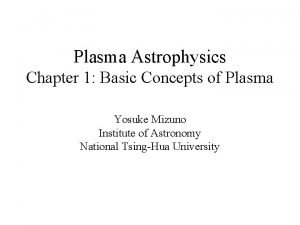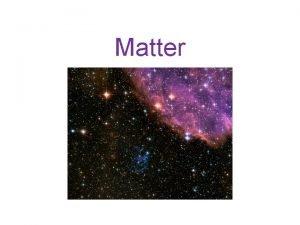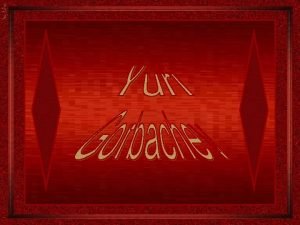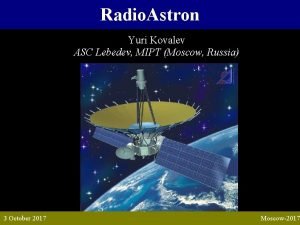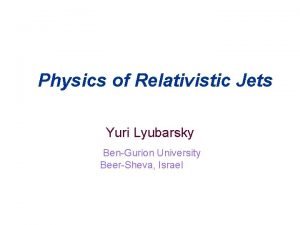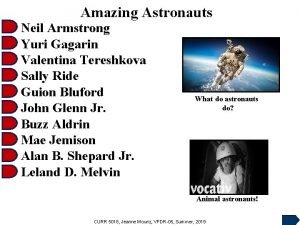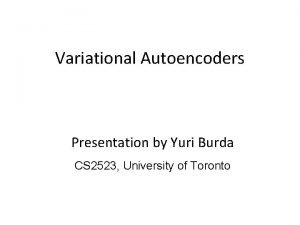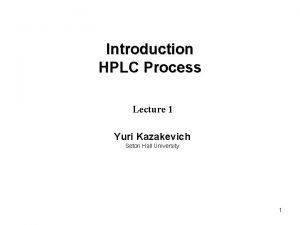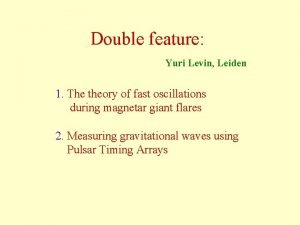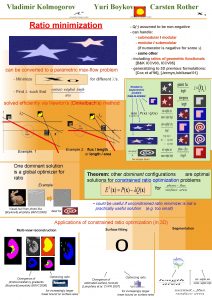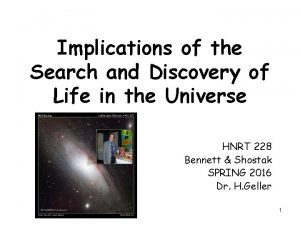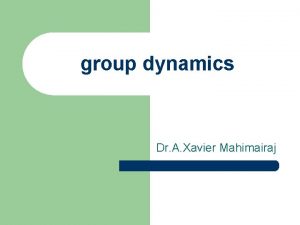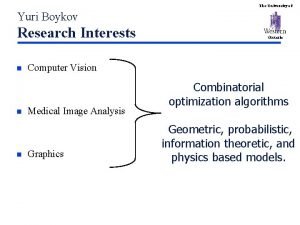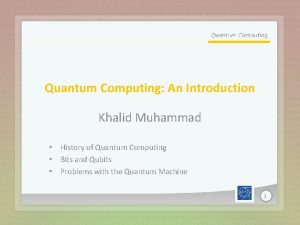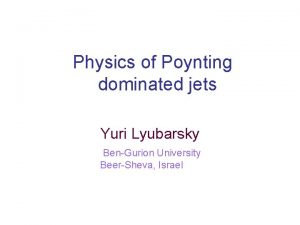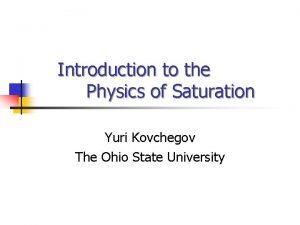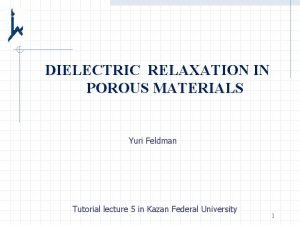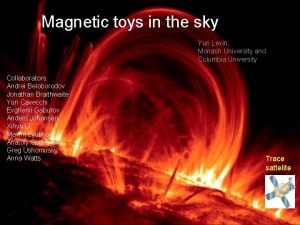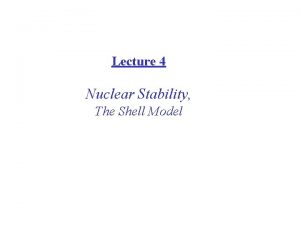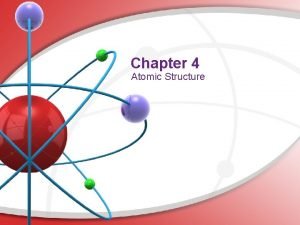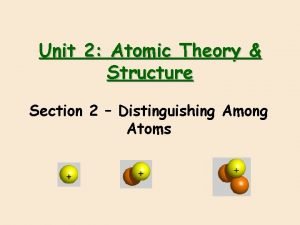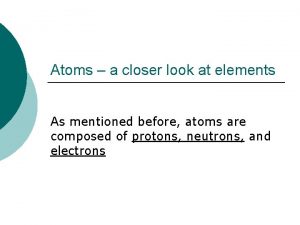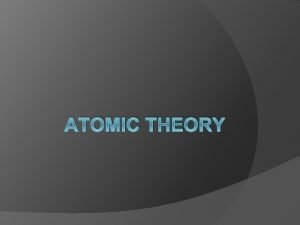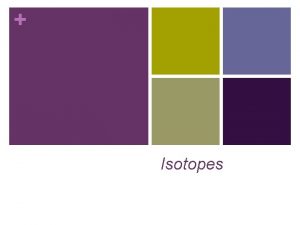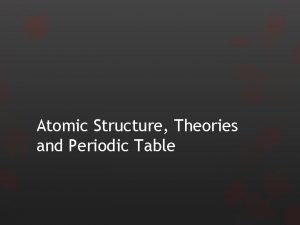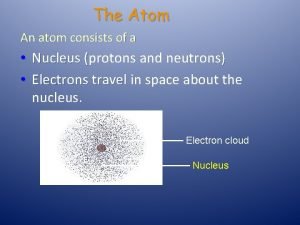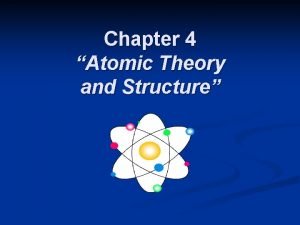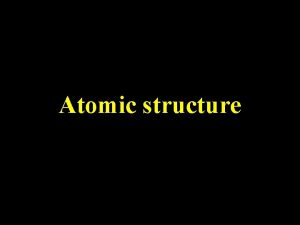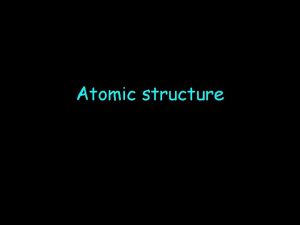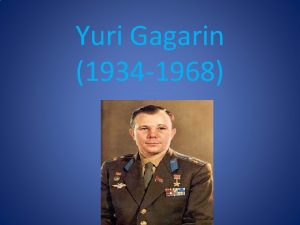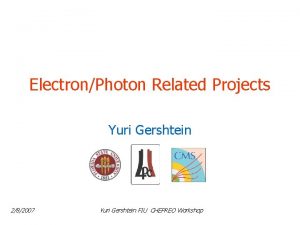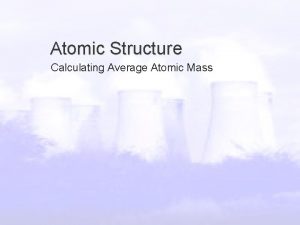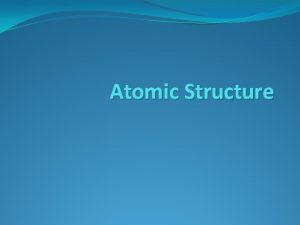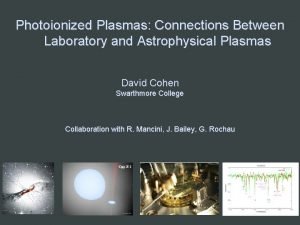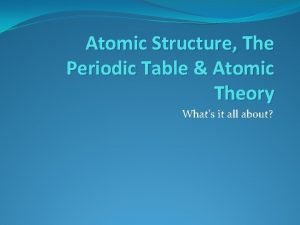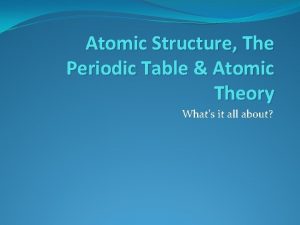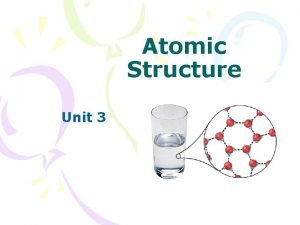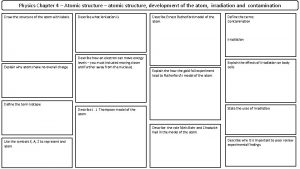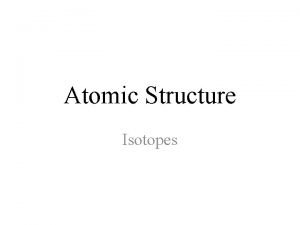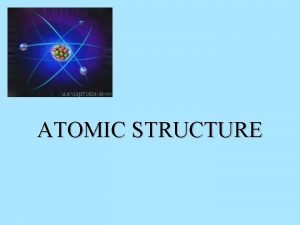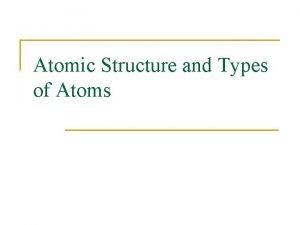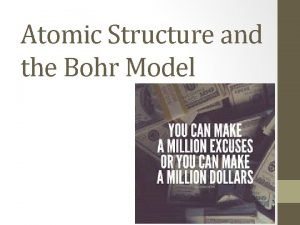Atomic structure whats in it for plasmas Yuri













































- Slides: 45

Atomic structure: what’s in it for plasmas? . . Yuri Ralchenko National Institute of Standards and Technology Gaithersburg, MD 20899, USA

Why is atomic structure important for plasmas? Most of the relevant physics is inside this matrix element final state • • • interaction operator initial state Wavelengths Energies Transition probabilities (radiative and non-radiative) Collisional cross sections …

A Few Textbooks on APP ● H. R. Griem – – ● R. D. Cowan – ● Theory of Atomic Structure and Spectra (1981) V. P. Shevelko and L. A. Vainshtein – ● Plasma Spectroscopy (1964) Principles of Plasma Spectroscopy (1997) Atomic Physics for Hot Plasmas (1993) D. Salzmann – Atomic Physics in Hot Plasmas (1998) • T. Fujimoto • Plasma Spectroscopy (2004) • H. -J. Kunze • Introduction to Plasma Spectroscopy (2009) • J. Bauche, C. Bauche. Arnoult, O. Peyrusse • Atomic Properties in Hot Plasmas (2015) • Modern Methods in Collisional-Radiative Modeling of Plasmas (2016) • HKC, HAS, YR, …

Units • Energy • 1 Ry = 13. 61 e. V = 109 737 cm-1 (ionization energy of H) • 1 e. V = 8065. 5447 cm-1 • Length • a 0 = 5. 29 10 -9 cm = 0. 529 Å (radius of H atom) • Area (cross section) • a 02 = 8. 8 10 -17 cm 2 (area of H atom) • New SI: 2018 http: //physics. nist. gov/cuu/Units/

16 -electron ion (S-like) Term Superconfiguration 1 P 12 24 34 44 52 3 s 23 p 3 d 24 p 3 P 1 D 12 28 35 41 Average atom 12 28 36 3 s 23 p 34 s Configuration 3 S 3 D Level 5 S 5 3 D 3 3 D 2 3 D 1

Thank you Nature, for Hydrogen and H-like ions 1 Ry = 13. 61 e. V Radius: Energy: Hydrogen atom H-like ion There’s no hydrogen atom for plasmas…

Exact quantum numbers for general atomic states •

Complex atoms (non-relativistic) We (generally) know all important interactions: The Schrödinger equation cannot be solved exactly…

Standard procedure •

Relativistic atomic structure: heavy and not so heavy ions Dirac-Coulomb Hamiltonian electron momentum operator 4 x 4 Dirac matrices extended nuclear charge distribution Transverse photons (magnetic interactions and retardation effects): QED effects: self energy (SE), vacuum polarization (VP)

Relativistic notations s 1/2 p 3/2 d 5/2 f 7/2 s p- p+ d- d+ f- f+ l 0 1 1 2 2 3 3 j ½ ½ 3/2 5/2 7/2

Atomic Structure Methods and Codes ● Coulomb approximation (Bates-Damgaard) ● Thomas-Fermi (SUPERSTRUCTURE, AUTOSTRUCTURE) ● Single-configuration Hartree-Fock (self-consistent field) – ● Cowan’s code, online interfaces available (more later) Model potential (including relativistic) – HULLAC, FAC ● Multiconfiguration HF (http: //nlte. nist. gov/MCHF) ● Multiconfiguration Dirac-Fock (MCDF) – GRASP 2 K (http: //nlte. nist. gov/MCHF) – Desclaux’s code ● Various perturbation theory methods ● B-splines http: //plasma-gate. weizmann. ac. il/directories/free-software/

Zc-scaling of one-electron energies Spectroscopic charge: Zc= ion charge + 1 (H I, Ar XV…) This is the charge that is seen by the outermost (valence) electron non-relativistic hydrogenic term Therefore, for high Zc the energy structure looks more and more H-like! Of course, relativistic effects slightly modify this dependence but the general trend remains valid

Energy structure of an ion electron-electron interaction ~Zc spin-orbit (relativistic effects) terms ~Zc 2 electron-nucleus interaction Every state is defined by a set of quantum numbers which are mostly approximate Electrons are grouped into shells nl (K n=1, L n=2, M n=3, . . . ) producing configurations (or even superconfigurations) levels ~Z 4

Mg-like Al II: 3 l 3 l' Ionization potential Grotrian diagram 2 p 63 s 2

Mg-like Sr XXVII: 3 l 3 l' Ionization potential 2 p 63 s 2

Spin-orbit interaction Hydrogenic ion: Semi-theoretical Lande formula: n*: effective n

Types of coupling • LS coupling: electron-electron » spin-orbit • light elements • jj coupling: spin-orbit » electron-electron • heavy elements • 2 s 2 p: (2 s 1/2, 2 p 1/2) or (2 s, 2 p-) • 3 d 5: ((3 d-3)5/2, (3 d+2)2)3/2 • Intermediate coupling: neither is stronger • Other types of couplings exist

Configuration sp: LS coupling (LSJ) M 1 P 1 P 1 +1 -1 0 +G 1 sp electrostatic -G 1 3 P terms spinorbit 3 P magnetic field +1 +2 -1 0 -2 +1 0 -1 0 2 3 P 1 3 P 0 levels states

Configuration sp: jj coupling (1/2, 3/2)1 +1 -1 0 (1/2, 3/2)2 sp spinorbit electrostatic (1/2, 1/2)1 +1 +2 -1 0 +1 0 -1 (1/2, 1/2)0 levels -2 magnetic field (1/2, 1/2) terms M 0 states

Intermediate coupling for sl: Fk(nl, n’l’): direct Coulomb (ll interactions) Gk(nl, n’l’): exchange Coulomb (ss interactions) 3 L 1 L 3 L 3 L l+1 l = F 0 – Gl + ½lζnl l l-1 = F 0 – Gl - ½(l+1)ζnl

From LS to jj: 1 s 2 p in He-like ions 1 P 1

Be-like Fe XXIII: n=2 levels

Be-like Fe XXIII: n=2 levels 84% 73% 90% 73% 86% 80% 83%

Spin-orbit interaction does depend on nuclear charge! Lande formula

Na-like doublet in highly-charged ions Fraunhofer absorption lines in the solar spectrum 0. 1% D 2 5890 Å 5896 Å D 1

Na-like doublet in highly-charged ions: 3 s-3 p Relative splitting 3 p 1/2 -3 p 3/2 2 0. 1% D 2 5890 Å 5896 Å D 1 1

Little Ions With a Big Charge Sodium Atom 11 electrons Sodium-like Tungsten (W 63+)

D-doublet in Na-like W, Hf, Ta, and Au J. D. Gillaspy et al, Phys. Rev. A 80, 010501 (2009)

Comparison of transition energies: RMBPT+QED vs experiment Uncertainties of the most advanced calc Red points: NIST EBIT (electron beam ion trap)

State mixing in intermediate coupling expansion coefficients He-like Na 9+: He-like Fe 24+: He-like Mo 40+: 1 s 2 p 3 P 1 = 0. 999 3 P + 0. 032 1 P 1 s 2 p 3 P 1 = 0. 960 3 P + 0. 281 1 P 1 s 2 p 3 P 1 = 0. 874 3 P + 0. 486 1 P s-o coupling increases with Z change of coupling scheme

Other types of coupling •

Hund’s rules (equivalent electrons, LS) CI 1. Largest S has the lowest energy 2. Largest L with the same S has the lowest energy 3. For atoms with less-than halffilled shells, lowest J has lowest energy

Superconfigurations Motivation: for very complex atoms (ions) not only the number of levels is overwhelmingly large, but also the number of configurations Example: 1 s 22 p 53 s 1 s 22 p 53 p 1 s 22 p 53 d 1 s 22 s 2 p 63 s 1 s 22 s 2 p 63 p 1 s 22 s 2 p 63 d different n’s (1 s)2(2 s 2 p)7(3 s 3 p 3 d)1 ≡ (1)2(2)7(3)1 BUT: (1 s)2(2 s 2 p)7(3 s 3 p 3 d 4 s 4 p 4 d 4 f)1 Instead of producing millions or billions of lines, SCs are used to calculate Super Transition Arrays Statistical methods FLYCHK, CRETIN! See J. Bauche et al’s book (2015)

Superconfigurations vs. detailed level accounting Ga: photoabsorption cross section Iglesias et al (1995)

Ionization potentials • IPs are directly connected with ionization distributions in plasmas • Most often are determined from Rydberg series

Ground state configurations (2004)

Collapse of fshells overlooked! Ground states change many times along these sequences

4 f-orbital collapse effective potential 49 In I 4 f 56 Ba I 6 s 4 f 57 La Orb Exp Z 3 d 20 4 d 38 5 d 56 4 f 57 5 f 90 5 g 124(th) I 4 f 6 s 2 50 Sn I 5 p 4 f 70 Yb I 4 f 14 6 s 2 50 Xe I 5 p 54 f 6 s

Ground state configurations (2004) We already know: Higher Zc, close to H-like! At Zc → ∞, [Xe] → 4 d 104 f 8!

Ionization potential: constant? . . • IP is a function of plasma conditions • High-lying states are no longer bound due to interactions with neighboring atoms, ions, and electrons • Orbit radius in H I: where is n=300, 000?

Isolated atom continuum n=3 n=2 n=1 n=4

Ionization potential depression unbound QM tunneling

Atomic Structure & Spectra Databases • Extensive list • http: //plasma-gate. weizmann. ac. il/directories/databases/ • Evaluated and recommended data • NIST Atomic Spectra Database http: //physics. nist. gov/asd • Level energies, ionization potentials, spectral lines, transition probabilities • Other data collections • • VALD (Sweden) SPECTR-W 3 (Russia) CAMDB (China) CHIANTI (USA/UK/…) Kurucz databases (USA) GENIE (IAEA) …

ASD • Contents • Procedure: evaluation, analysis • Basic search of energies • Units, ascii, • Term energies • Spectral lines • Multiplets • Grotrian diagrams
 What are plasmas
What are plasmas What are plasmas
What are plasmas Atomic mass and atomic number difference
Atomic mass and atomic number difference Relative atomic mass of beryllium
Relative atomic mass of beryllium Trends of periodic table
Trends of periodic table Atomic radius of arsenic
Atomic radius of arsenic How to calculate abundance of isotopes
How to calculate abundance of isotopes Atomic number vs atomic radius
Atomic number vs atomic radius Yuri klapouh
Yuri klapouh Yuri gorbachev paintings
Yuri gorbachev paintings Yuri kovalev
Yuri kovalev Yuri lyubarsky
Yuri lyubarsky Armen yuri gasparyan
Armen yuri gasparyan Yuri armstrong
Yuri armstrong Yuri burda
Yuri burda Yuri kazakevich
Yuri kazakevich Yuri levin
Yuri levin Vladimir kolmogorov
Vladimir kolmogorov Knozorov
Knozorov Dr yuri levin
Dr yuri levin Stellas diner camillus
Stellas diner camillus Valentina tereshkova passage
Valentina tereshkova passage Yuri boykov
Yuri boykov Yuri manin
Yuri manin Yuri lyubarsky
Yuri lyubarsky Yuri milner
Yuri milner Yuri kovchegov
Yuri kovchegov Yuri
Yuri Yuri plowden
Yuri plowden Yuri bezmenov
Yuri bezmenov Vddpst
Vddpst Cavecchi type
Cavecchi type Andrey remnev
Andrey remnev Yuri garigan
Yuri garigan Whats the trend for atomic radius
Whats the trend for atomic radius Whats heliums atomic mass
Whats heliums atomic mass Whats the atomic mass of boron
Whats the atomic mass of boron Atoms
Atoms Atomic size
Atomic size Whats the atomic mass of uranium
Whats the atomic mass of uranium The atom from philosophical idea to scientific theory
The atom from philosophical idea to scientific theory Whats the atomic number of w
Whats the atomic number of w Whats the atomic number for silver
Whats the atomic number for silver Whats the atomic number of boron
Whats the atomic number of boron Whats the charge of a nucleus
Whats the charge of a nucleus Whats the atomic mass of argon
Whats the atomic mass of argon
